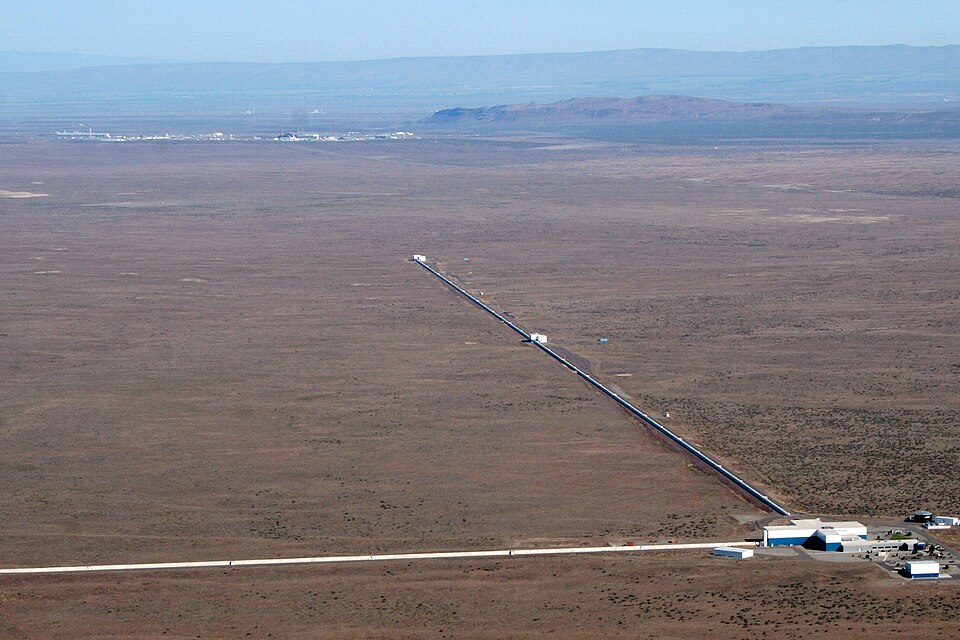
What are gravitational waves? Gravitational waves are ripples in spacetime that head through space like ripples on a pond, except in three dimensions. They travel at the speed of light, and they compress space as they pass. They are caused by violent events, such as when two black holes collide.
Everything that has mass has gravity. The more mass something has, the more gravity it has. That doesn’t necessarily mean that larger things have more mass because something can be large and not very dense, such as the gas giants, or small and very dense, such as a neutron star. Everything with gravity affects the fabric of space around it, but in relation to the amount of mass they have. I affect the fabric of space around me, but my effect is negligible when compared to that of the Earth, which, in turn, is negligible when compared to that of a black hole.
All bodies in space curve spacetime, and when something has an enormous amount of gravity, it can send ripples out through space. These are called gravitational waves. These waves travel through space in a similar way to waves travelling across the surface of a pond. They travel at the speed of light. Each of the waves has energy, but as they travel through space, they lose some of the energy over time. They keep losing energy until they disappear completely, just like a wave on a pond. They don’t lose energy when they hit planets and stars, but pass through them.
Everything creates waves, but only significant bodies or sources of energy produce waves that are big enough to travel far across space. These kinds of bodies would be exploding neutron stars, or two neutron stars, or two black holes colliding. When neutron stars or black holes come close to each other, they start by orbiting each other. As they get closer, their orbit gets faster and faster, and they release more and more energy. When two black holes collide, they can put out 50 times more energy than all of the stars in the observable universe combined, but only for a few microseconds. This incredible energy becomes gravitational waves. The waves spread out from the source in all directions, just like a stone dropped in a lake, but they are different because they don’t require a medium. Waves in water move through the molecules of water. Sound waves also require molecules to propagate the energy. Gravitational waves move through the fabric of space itself and don’t need any molecules. They are a disturbance in space-time. As the wave moves through space, it squashes the fabric of space together and then moves on.
Gravitational waves were theorized by Einstein. He thought that if his general theory of relativity was correct, then there should be gravitational waves. The problem was that they would be very difficult to detect. It was only in 2015 that astronomers were finally able to detect a gravitational wave. One wave was detected by a pair of observatories in the USA. The observatories are called the Laser Interferometer Gravitational-Wave Observatories (LIGO). Each observatory has a central hub and two 4 km long arms that spread out in an L shape. Each arm has a 1.2 m wide steel vacuum tube and a mirror at the end. A laser is fired from the central hub and split so it goes down the two arms, hits the mirrors at the end, and reflects back. The speed of light in a vacuum is constant, and both laser beams return at exactly the same time, get recombined, and cancel each other out so that no light reaches a detector. If a gravitational wave passes through Earth, it slightly stretches the Earth, which moves one arm of the LIGO detector further out. That means the laser from one side returns slightly after the first laser, and some light reaches the detector. However, this light is minuscule because the gravitational wave has almost no power left when it reaches us. The wave detected in 2015 came from the merger of 2 black holes a billion light years away. When the gravitational wave reached Earth and was detected, it moved one arm of the LIGO by one thousandth the width of a proton. It is great to be able to detect gravitational waves, and astronomers can use the information to see where they have come from and what has produced them. It allows us to know more about our universe. And this is what I learned today.
Sources
https://en.wikipedia.org/wiki/Gravitational_wave
https://en.wikipedia.org/wiki/First_observation_of_gravitational_waves
https://www.ligo.caltech.edu/page/what-are-gw
https://spaceplace.nasa.gov/gravitational-waves/en
https://www.ligo.caltech.edu/page/what-is-ligo
https://physics.stackexchange.com/questions/713211/how-do-gravitational-waves-propagate
Image By LIGO Laboratory – https://web.archive.org/web/20170614214509/http://www.ligo.org/multimedia/gallery/lho-images/Aerial5.jpg, Public Domain, https://commons.wikimedia.org/w/index.php?curid=62647711
